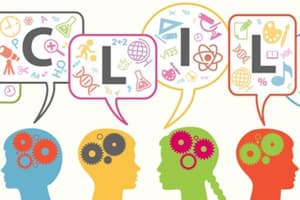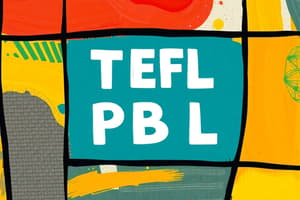Podcast
Questions and Answers
What does the term 'method' imply in the context of language teaching?
What does the term 'method' imply in the context of language teaching?
- An application of an approach in language teaching (correct)
- A system of practices and procedures used by teachers
- A theoretical foundation for language learning
- A specific practical task for students
Which of the following statements best describes the difference between 'methodology' and 'method'?
Which of the following statements best describes the difference between 'methodology' and 'method'?
- Methodology is about specific classroom tasks; method is an umbrella term.
- Methodology refers to the teacher's beliefs; method refers to the practical application. (correct)
- Method is about the theoretical foundation; methodology is about techniques.
- Method is focused on student roles; methodology is focused on content delivery.
Which traditional teaching method characteristic typically hinders collaboration among students?
Which traditional teaching method characteristic typically hinders collaboration among students?
- Encouragement of peer feedback
- Teacher as the primary source of knowledge (correct)
- Focus on student-led discussions
- Use of group projects and presentations
What is an essential component of a 'method' in language teaching?
What is an essential component of a 'method' in language teaching?
How do 'approach' and 'method' differ in language teaching?
How do 'approach' and 'method' differ in language teaching?
Which of the following statements about the Silent Way method is true?
Which of the following statements about the Silent Way method is true?
What role does the syllabus play in a language teaching method?
What role does the syllabus play in a language teaching method?
What misconception might students have about the role of technology in traditional teaching methods?
What misconception might students have about the role of technology in traditional teaching methods?
Which method is characterized by its reliance on physical motions and gestures to aid learning?
Which method is characterized by its reliance on physical motions and gestures to aid learning?
Which past trend in TEFL emphasizes interaction and communication among learners?
Which past trend in TEFL emphasizes interaction and communication among learners?
What is the primary focus of traditional teaching methods?
What is the primary focus of traditional teaching methods?
Which of the following is NOT considered a designer method?
Which of the following is NOT considered a designer method?
What aspect is emphasized in designer methods?
What aspect is emphasized in designer methods?
How do designer methods differ from traditional methods regarding classroom dynamics?
How do designer methods differ from traditional methods regarding classroom dynamics?
What belief is commonly held by traditional language teachers about teaching materials?
What belief is commonly held by traditional language teachers about teaching materials?
In the context of traditional language classes, what is typically expected from student roles?
In the context of traditional language classes, what is typically expected from student roles?
What is a characteristic of the classroom atmosphere prioritized in designer methods?
What is a characteristic of the classroom atmosphere prioritized in designer methods?
What is the primary view of teachers regarding language learning in traditional methods?
What is the primary view of teachers regarding language learning in traditional methods?
What kind of activities are frequently used in traditional language classes?
What kind of activities are frequently used in traditional language classes?
What is common about the designer methods developed in the 1970s and 1980s?
What is common about the designer methods developed in the 1970s and 1980s?
Flashcards
Methodology
Methodology
A set of principles and procedures that a teacher uses to teach a language, informed by beliefs about language and learning.
Approach
Approach
A theoretical framework for language teaching, based on ideas about how languages should be learned.
Method
Method
A practical application of an approach in the language classroom. It includes specific practices, procedures, and materials.
Techniques
Techniques
Signup and view all the flashcards
Syllabus
Syllabus
Signup and view all the flashcards
Traditional Teaching
Traditional Teaching
Signup and view all the flashcards
Chalk and Talk
Chalk and Talk
Signup and view all the flashcards
Communicative Language Teaching (CLT)
Communicative Language Teaching (CLT)
Signup and view all the flashcards
Total Physical Response (TPR)
Total Physical Response (TPR)
Signup and view all the flashcards
Suggestopedia
Suggestopedia
Signup and view all the flashcards
Community Language Learning (CLL)
Community Language Learning (CLL)
Signup and view all the flashcards
Chomskyan Revolution
Chomskyan Revolution
Signup and view all the flashcards
Deep Structure
Deep Structure
Signup and view all the flashcards
Designer Methods
Designer Methods
Signup and view all the flashcards
Communicative View of Language
Communicative View of Language
Signup and view all the flashcards
Acquisition Theory
Acquisition Theory
Signup and view all the flashcards
Study Notes
TEFL Approaches: CLIL and PBL
- Course instructor: Ph.D., Kymbat Smakove
- Course code: TFL 613
Past TEFL Trends (20th Century)
- Grammar-Translation
- Direct Method
- Audio-lingual Method
- Community Language Learning
- The Silent Way
- Suggestopedia
- Total Physical Response
- Natural Approach
- Communicative Language Teaching
Definitions of Language Teaching Concepts
- Approach: The theory or philosophy behind how a language is taught. Provides the theoretical foundation and principles about language and language learning.
- Methodology: The study and analysis of methods and practices informed by the approach.
- Method: A practical plan and techniques derived from the methodology and approach, a way of implementing the approach (syllabus, progression, kinds of materials).
- Techniques: Specific practical classroom tasks and activities.
Components of Language Teaching Methodology
- Theories of Language and Learning (informs the approach)
- Instructional Design Features (informs the methodology)
- Observed Teaching Practices (result of applying the methodology and method)
Syllabi
- Organized content and objectives sequenced and taught using methods
Traditional Language Class Features
- Teacher-centric classrooms; teachers are knowledge dispensers, not facilitators
- Chalk and talk methods dominate
- Regimented classrooms.
- Lack of collaboration, group learning, and student interaction
- Primary teaching goal is exam preparation, and passing
Other Methods
- Community Language Learning
- The Silent Way
- Suggestopedia
- TPR (Total Physical Response)
The Chomskyan Revolution
- linguists and teachers focus on language's deep structure
- psychologists consider affective and interpersonal learning
Designer Methods
- Innovative methods such as Total Physical Response (TPR) and Community Language Learning (CLL) emerged in the 1970s and 1980s.
- These approaches emphasized affective-humanistic principles, student involvement, and creating a positive classroom atmosphere.
Contemporary Language Classroom Features
- Emphasis on respect and self-respect
- Active student participation and personal experience
- Interactive activities such as pair and group work are widespread
Task Descriptions
- Task 1: Describe common features of traditional language classes.
- Task 2: List 21st-century trends in TEFL/TESOL.
- Task 3: Describe common features of contemporary language classes.
Additional Issues
- Issues about suitability of certain methods
- Reasons for the move away from finding "one best method" in the 1990s and afterward
Studying That Suits You
Use AI to generate personalized quizzes and flashcards to suit your learning preferences.




